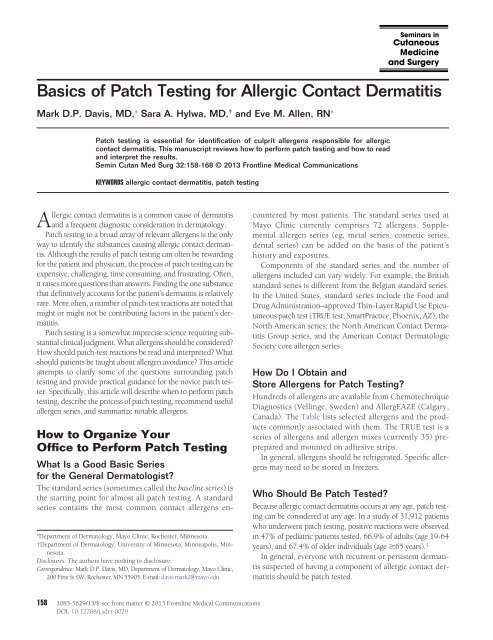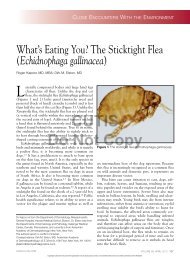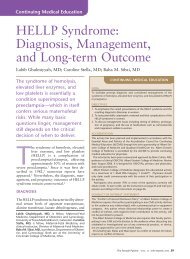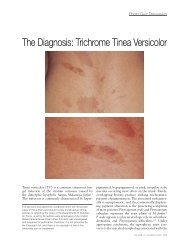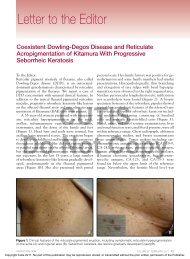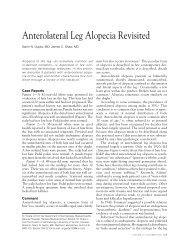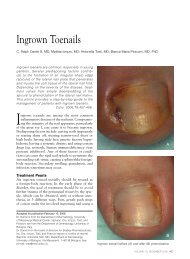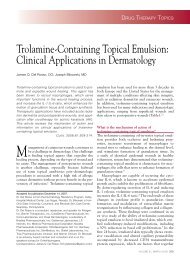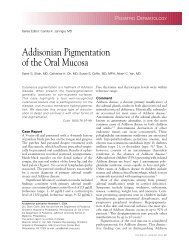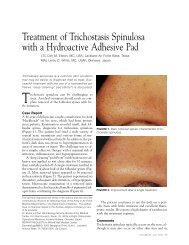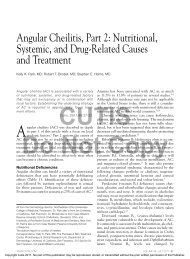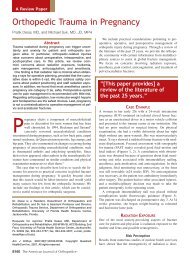Basics of Patch Testing for Allergic Contact Dermatitis - Cosmetic ...
Basics of Patch Testing for Allergic Contact Dermatitis - Cosmetic ...
Basics of Patch Testing for Allergic Contact Dermatitis - Cosmetic ...
Create successful ePaper yourself
Turn your PDF publications into a flip-book with our unique Google optimized e-Paper software.
<strong>Basics</strong> <strong>of</strong> <strong>Patch</strong> <strong>Testing</strong> <strong>for</strong> <strong>Allergic</strong> <strong>Contact</strong> <strong>Dermatitis</strong><br />
Mark D.P. Davis, MD, Sara A. Hylwa, MD, † and Eve M. Allen, RN <br />
<strong>Patch</strong> testing is essential <strong>for</strong> identification <strong>of</strong> culprit allergens responsible <strong>for</strong> allergic<br />
contact dermatitis. This manuscript reviews how to per<strong>for</strong>m patch testing and how to read<br />
and interpret the results.<br />
Semin Cutan Med Surg 32:158-168 © 2013 Frontline Medical Communications<br />
KEYWORDS allergic contact dermatitis, patch testing<br />
<strong>Allergic</strong> contact dermatitis is a common cause <strong>of</strong> dermatitis<br />
and a frequent diagnostic consideration in dermatology.<br />
<strong>Patch</strong> testing to a broad array <strong>of</strong> relevant allergens is the only<br />
way to identify the substances causing allergic contact dermatitis.<br />
Although the results <strong>of</strong> patch testing can <strong>of</strong>ten be rewarding<br />
<strong>for</strong> the patient and physician, the process <strong>of</strong> patch testing can be<br />
expensive, challenging, time consuming, and frustrating. Often,<br />
it raises more questions than answers. Finding the one substance<br />
that definitively accounts <strong>for</strong> the patient’s dermatitis is relatively<br />
rare. More <strong>of</strong>ten, a number <strong>of</strong> patch-test reactions are noted that<br />
might or might not be contributing factors in the patient’s dermatitis.<br />
<strong>Patch</strong> testing is a somewhat imprecise science requiring substantial<br />
clinical judgment. What allergens should be considered?<br />
How should patch-test reactions be read and interpreted? What<br />
should patients be taught about allergen avoidance? This article<br />
attempts to clarify some <strong>of</strong> the questions surrounding patch<br />
testing and provide practical guidance <strong>for</strong> the novice patch tester.<br />
Specifically, this article will describe when to per<strong>for</strong>m patch<br />
testing, describe the process <strong>of</strong> patch testing, recommend useful<br />
allergen series, and summarize notable allergens.<br />
How to Organize Your<br />
Office to Per<strong>for</strong>m <strong>Patch</strong> <strong>Testing</strong><br />
Department <strong>of</strong> Dermatology, Mayo Clinic, Rochester, Minnesota.<br />
†Department <strong>of</strong> Dermatology, University <strong>of</strong> Minnesota, Minneapolis, Minnesota.<br />
Disclosures: The authors have nothing to disclosure.<br />
Correspondence: Mark D.P. Davis, MD, Department <strong>of</strong> Dermatology, Mayo Clinic,<br />
200 First St SW, Rochester, MN 55905. E-mail: davis.mark2@mayo.edu<br />
What Is a Good Basic Series<br />
<strong>for</strong> the General Dermatologist?<br />
The standard series (sometimes called the baseline series)is<br />
the starting point <strong>for</strong> almost all patch testing. A standard<br />
series contains the most common contact allergens encountered<br />
by most patients. The standard series used at<br />
Mayo Clinic currently comprises 72 allergens. Supplemental<br />
allergen series (eg, metal series, cosmetic series,<br />
dental series) can be added on the basis <strong>of</strong> the patient’s<br />
history and exposures.<br />
Components <strong>of</strong> the standard series and the number <strong>of</strong><br />
allergens included can vary widely. For example, the British<br />
standard series is different from the Belgian standard series.<br />
In the United States, standard series include the Food and<br />
Drug Administration–approved Thin-Layer Rapid Use Epicutaneous<br />
patch test (TRUE test; SmartPractice; Phoenix, AZ), the<br />
North American series, the North American <strong>Contact</strong> <strong>Dermatitis</strong><br />
Group series, and the American <strong>Contact</strong> Dermatologic<br />
Society core allergen series.<br />
How Do I Obtain and<br />
Store Allergens <strong>for</strong> <strong>Patch</strong> <strong>Testing</strong>?<br />
Hundreds <strong>of</strong> allergens are available from Chemotechnique<br />
Diagnostics (Vellinge, Sweden) and AllergEAZE (Calgary,<br />
Canada). The Table lists selected allergens and the products<br />
commonly associated with them. The TRUE test is a<br />
series <strong>of</strong> allergens and allergen mixes (currently 35) preprepared<br />
and mounted on adhesive strips.<br />
In general, allergens should be refrigerated. Specific allergens<br />
may need to be stored in freezers.<br />
Who Should Be <strong>Patch</strong> Tested?<br />
Because allergic contact dermatitis occurs at any age, patch testing<br />
can be considered at any age. In a study <strong>of</strong> 31,912 patients<br />
who underwent patch testing, positive reactions were observed<br />
in 47% <strong>of</strong> pediatric patients tested, 66.9% <strong>of</strong> adults (age 19-64<br />
years), and 67.4% <strong>of</strong> older individuals (age 65 years). 1<br />
In general, everyone with recurrent or persistent dermatitis<br />
suspected <strong>of</strong> having a component <strong>of</strong> allergic contact dermatitis<br />
should be patch tested.<br />
158 1085-5629/13/$-see front matter © 2013 Frontline Medical Communications<br />
DOI: 10.12788/j.sder.0029
<strong>Patch</strong> testing basics 159<br />
Table Selected Common Allergens Associated With <strong>Allergic</strong> <strong>Contact</strong> <strong>Dermatitis</strong><br />
Allergen (ACDS ‘Allergen<br />
<strong>of</strong> the Year’ [Designation] a ) Products Comment<br />
Acrylate [2012] Sculptured nails, dental products Used to <strong>for</strong>m plastics and glues<br />
Unpolymerized (monomeric) <strong>for</strong>m can<br />
penetrate through rubber gloves,<br />
whereas the polymerized <strong>for</strong>m is<br />
inert (harmless)<br />
Bacitracin [2003]<br />
Balsam <strong>of</strong> Peru<br />
Black rubber mix<br />
Bronopol<br />
Budesonide [2005 b ]<br />
Caine mix (benzocaine,<br />
tetracaine, dibucaine)<br />
Carba mix (diphenylguanidine,<br />
zinc dibutyldithiocarbamate,<br />
zinc diethyldithiocarbamate)<br />
Cl-Me isothiazolinone [2013]<br />
Cobalt dichloride<br />
Cocamidopropyl betaine [2004]<br />
Colophony<br />
Over-the-counter and prescription topical<br />
antibiotics<br />
Perfumes, cosmetics, candles, cleaning<br />
products, essential oils, gum, powders,<br />
flavored tobaccos, food products<br />
(tomatoes, citrus, chocolate, colas, wine,<br />
liquors, cinnamon, vanilla, spices)<br />
Shoes, tires, belts, hoses, cables, sports<br />
equipment<br />
Personal care products (shampoo),<br />
cosmetics, food preservative, orthopedic<br />
casts, root canal disinfectants, paints,<br />
glues, home detergents<br />
Corticosteroid screening agent<br />
First-aid analgesics, antiseptics, other topic<br />
pain relievers<br />
Rubber products (gloves, shoes, rubber<br />
bands, erasers, toys), swimwear, hosing,<br />
neoprene, fungicides, pesticides<br />
Moist personal hygiene wipes, cutting fluids,<br />
cooling liquids, latex paints, skin products,<br />
hair care products, cosmetics, glues<br />
Jewelry, tools, pigments, keys, dental and<br />
orthopedic implants, bricks, cement,<br />
plastics<br />
Suds-<strong>for</strong>ming products (shampoos, hand<br />
soaps, body washes)<br />
Personal care products (diapers, feminine<br />
pads), cosmetics and personal creams,<br />
glues, polishes, waxes, wood products,<br />
inks, lacquers, neoprene, polyethylene,<br />
oils, colored pencils<br />
Topical antibiotic<br />
Rash <strong>of</strong>ten takes 3-5 d to develop (late<br />
reactor)<br />
Fragrance<br />
Rubber<br />
Formaldehyde-releasing preservative<br />
Antimicrobial, fungicide, germicide<br />
Can <strong>for</strong>m nitrosamines, which are<br />
carcinogenic (use is decreasing)<br />
Anesthetics<br />
Rubber product manufacturing<br />
Contains methylchloroisothiazolinone/<br />
methylisothiazolinone<br />
Preservative<br />
Be suspicious <strong>of</strong> this allergen in cases<br />
<strong>of</strong> dermatitis affecting the genital<br />
area<br />
Metal<br />
Co-sensitization with nickel<br />
Nonionic surfactant and foaming agent,<br />
popular in commercial products<br />
because it is less irritating than older<br />
surfactants<br />
Two chemicals used in its synthesis:<br />
amidoamine and<br />
dimethylaminopropylamine<br />
Coniferous tree (pine) sap<br />
Diazolidinyl urea Cleansers, detergents, cosmetics Antimicrobial preservative<br />
Dimethyl fumarate [2011] Antimicrobial in sachets used in furniture<br />
manufactured in China<br />
Disperse blue 106 [2000]<br />
Epoxy resin<br />
Common in polyester lining in women’s<br />
clothing<br />
Glues, adhesives, flooring, dental epoxies,<br />
art, sculpture<br />
Biocide<br />
May cause dermatitis <strong>of</strong> back,<br />
buttocks, and parts <strong>of</strong> upper/lower<br />
extremities, depending on exposure<br />
Fabric dye<br />
Found in curing agents but is not<br />
sensitizing when cured<br />
Will penetrate rubber but not vinyl<br />
gloves
160 M.D.P. Davis, S.A. Hylwa, and E.M. Allen<br />
Table Selected Common Allergens Associated With <strong>Allergic</strong> <strong>Contact</strong> <strong>Dermatitis</strong> (Continued)<br />
Allergen (ACDS ‘Allergen<br />
<strong>of</strong> the Year’ [Designation] a ) Products Comment<br />
Ethylenediamine<br />
dihydrochloride<br />
Formaldehyde<br />
Manufacturing (chelators, curing agents,<br />
surfactants, dispersants, binders,<br />
carbamates, fuel additives), generic<br />
nystatin creams<br />
Fabric finishes, construction materials<br />
(plywood, glues, paints, varnishes),<br />
polishes, photography materials, personal<br />
care products, cosmetics, smoke<br />
Manufacturing (drugs, industrial<br />
compounds)<br />
Preservative and disinfectant<br />
Fragrance mix [2007] Included in most skin care products Look <strong>for</strong> products that are “fragrance<br />
free”<br />
Gold sodium thiosulfate [2001] Jewelry, electronics, dental restorations,<br />
intracoronary stents<br />
Hydrocortisone-17-butyrate<br />
[2005 b ]<br />
Imidazolidinyl urea<br />
Mercapto mix<br />
Corticosteroid screening agent<br />
Personal products (cleansers, moisturizers),<br />
cosmetics<br />
Rubber products (shoes, goggles, mats,<br />
headphones, tubing, gloves, erasers,<br />
wetsuits, sports equipment)<br />
Metal<br />
Consider in hand, neck dermatitis<br />
May be the source <strong>of</strong> “atopic<br />
dermatitis” <strong>of</strong> the eyelids<br />
Preservative<br />
N-Cyclohexyl-2-benzothiazyl<br />
sulfenamide, dibenzothiazyl disulfide,<br />
2-(4-morpholinyl mercaptol)<br />
benzothiazole<br />
Rubber manufacturing<br />
Fungicide, microbicide<br />
Mercaptobenzothiazole<br />
Pesticides, rubber products, sports<br />
equipment<br />
Methyldibromo glutaronitrile Cutting oils, glues, adhesives, skin care and Preservative<br />
personal hygiene products<br />
Mixed dialkyl thioureas [2009] Clothing, scuba suits, spandex Rubber chemicals used in production<br />
<strong>of</strong> neoprene and spandex<br />
Neomycin sulfate [2010] Over-the-counter antibiotic preparations Common topical antibiotic<br />
Rash <strong>of</strong>ten takes 3-5 days to develop<br />
(late reactor)<br />
Nickel sulfate [2008]<br />
p-tert-Butylphenol <strong>for</strong>maldehyde<br />
resin<br />
Paraben mix<br />
Paraphenylenediamine [2006]<br />
Parthenolide (sesquiterpene<br />
lactone)<br />
Potassium dichromate<br />
Costume jewelry, coins, keys, tools,<br />
buttons, snaps<br />
Glues, surface coating, adhesives (in shoes,<br />
upholstery, leather), electrocardiogram<br />
electrodes, fiberglass<br />
Hair care products, personal hygiene<br />
products (creams, shaving products),<br />
cosmetics, antiseptics, lip balms, some<br />
foods<br />
Hair dye, black henna, clothing dye, ink,<br />
photographic developers<br />
Plants, garden, floral shops, herbal<br />
supplements<br />
Wet cement, chrome, stainless steel, tanned<br />
leather products (shoes), pigments and<br />
inks, chromic gut surgical sutures, green<br />
dyes in felt and textiles, wood<br />
preservatives, cosmetics, construction<br />
materials<br />
Metal<br />
Commonest allergen<br />
Dimethylgloxime text can detect nickel<br />
in products<br />
Coat <strong>of</strong> clear nail polish is an effective<br />
barrier<br />
Formaldehyde resin<br />
Preservative<br />
Least common sensitizer <strong>of</strong> all<br />
preservatives<br />
Black dye<br />
Natural product in flowers and fruit <strong>of</strong><br />
feverfew<br />
Metal-chromium salt<br />
Propylene glycol Personal care products, cosmetics Preservative, humectant, emollient, and<br />
spreader<br />
Can be an irritant
<strong>Patch</strong> testing basics 161<br />
Table Selected Common Allergens Associated With <strong>Allergic</strong> <strong>Contact</strong> <strong>Dermatitis</strong> (Continued)<br />
Allergen (ACDS ‘Allergen<br />
<strong>of</strong> the Year’ [Designation] a ) Products Comment<br />
Quaternium-15<br />
Quinoline mix<br />
Thimerosal [2002]<br />
Thiuram mix (tetramethylthiuram<br />
monosulfide, disulfiram,<br />
tetramethylthiuram disulfide,<br />
dipentamethylenethiuram<br />
disulfide)<br />
Tixocortol-21-pivalate [2005 b ]<br />
Wool alcohols (lanolin)<br />
Insulation, embalming and preserving fluids,<br />
glues, inks, toners, paints, waxes,<br />
polishes, particleboard, cosmetics, skin<br />
care and personal hygiene products,<br />
household cleaners, smoke<br />
Topical antifungals, antibacterials, paste<br />
bandages<br />
Topical (eye) medications, antiseptic sprays,<br />
fluorescent dyes, cosmetics, vaccines<br />
Rubber products (gloves, shoes, neoprene,<br />
rubber bands, erasers, tubing masks,<br />
sports equipment), pesticides, fungicides,<br />
repellents<br />
Corticosteroid screening agent<br />
Lotions, cosmetics, metal-working fluids,<br />
waxes, shoe polishes<br />
a Annually, the ACDS names an “Allergen <strong>of</strong> the Year” to draw attention to an important allergen.<br />
b In 2005, corticosteroids were named the Allergen <strong>of</strong> the Year.<br />
Abbreviation: ACDS, American <strong>Contact</strong> <strong>Dermatitis</strong> Society.<br />
Preservative (<strong>for</strong>maldehyde-releasing<br />
agent)<br />
Antimicrobial<br />
Preservative and antiseptic<br />
Thimerosal-containing vaccinations are<br />
safe (including in children), even if<br />
patch testing is positive<br />
Rubber manufacturing<br />
From fleece <strong>of</strong> sheep<br />
What Allergen Series<br />
Should I Use to <strong>Patch</strong> Test a Patient?<br />
A standard allergen series should be used. Additionally, it is<br />
reasonable to patch-test patients to suspected personal skin<br />
care products. If particular exposures are not covered by the<br />
standard series, a specialized series may be added. For example,<br />
a hairdresser with hand dermatitis should be patch tested to the<br />
standard series and to a series containing allergenic chemicals<br />
commonly found in a salon. Most dermatologists patch test only<br />
to a standard series. Referral to a patch-test center may be<br />
needed if more extensive testing is necessary. <strong>Patch</strong> testing also<br />
can be considered <strong>for</strong> patients with dermatitis or other dermatoses<br />
because any dermatosis can be complicated by allergic<br />
contact dermatitis.<br />
Who Is a Good<br />
Candidate <strong>for</strong> <strong>Patch</strong> <strong>Testing</strong>?<br />
Ideally, patients who undergo patch testing will have normal<br />
skin at the test area (usually the back) and are not immunosuppressed.<br />
Patients with widespread or generalized dermatitis generally<br />
are unsuitable candidates. Suboptimal circumstances <strong>for</strong><br />
patch testing include patients receiving immunosuppressive<br />
medications, undergoing UV light treatment (including frequent<br />
tanning), and applying topical corticosteroids to their<br />
backs 2 to 3 weeks be<strong>for</strong>e testing. These conditions can be associated<br />
with false-negative or invalid results.<br />
How Do I Prepare Patients <strong>for</strong> <strong>Patch</strong> <strong>Testing</strong>?<br />
Relevant in<strong>for</strong>mation <strong>for</strong> patients 2 is summarized in the online<br />
Appendix (http://www.skinandallergynews.com/scmsjournal/volume-32/september-dermatitis.html).<br />
If patients<br />
prefer to watch instructional videos, they can be referred to<br />
the My<strong>Patch</strong>Link website. 3<br />
Protocol <strong>for</strong> <strong>Patch</strong> <strong>Testing</strong><br />
How Are <strong>Patch</strong> Tests Prepared and Applied?<br />
Individual allergens from Chemotechnique and AllergEAZE are<br />
sold in prefilled syringes, compounded with either a petrolatum<br />
(pet) or alcohol base. Preparation <strong>of</strong> these materials <strong>for</strong> patch<br />
testing is shown in Figure 1. 4 The TRUE test has pre-prepared<br />
allergens mounted on discs and is ready <strong>for</strong> application upon<br />
package opening. A diagram indicating the locations <strong>of</strong> applied<br />
allergens (Figure 2) should be included in the patient’s chart <strong>for</strong><br />
reference during patch-test readings.<br />
Allergens should be applied to dermatitis-free skin, most<br />
commonly on the back. If the back is dermatitic, alternative<br />
locations include the abdomen, thighs, or lateral arms. Avoid<br />
applying patches over nevis, scars, or tattoos. Typically,<br />
patch tests are applied in strips from left to right on the<br />
patient’s back, beginning with the upper left back. The next<br />
chamber is applied closely adjacent to the first chamber but<br />
without overlap.<br />
What Type <strong>of</strong> Schedule Is Needed?<br />
The entire patch-test process generally requires 5 to 7 days,<br />
depending on the clinic. Often, testing is per<strong>for</strong>med using a<br />
“Monday, Wednesday, Friday” schedule.<br />
Day 1 (eg, Monday): by definition, this is the day<br />
patches are applied (Figure 3A)
162 M.D.P. Davis, S.A. Hylwa, and E.M. Allen<br />
Figure 1 Preparing <strong>for</strong> patch testing. (A) Aluminum discs (Finn chambers) are premounted on (Scanpor) tape. (B)<br />
Allergens prepared in petrolatum are applied directly to the aluminum discs. (C) Allergens prepared in alcohol are<br />
applied to paper on the aluminum discs. (D) A tray with the Mayo Clinic standard series <strong>of</strong> allergens, ready to apply.<br />
Day 3 (eg, Wednesday): patches are removed and reactions<br />
are initially interpreted (Figure 3B). This first reading<br />
should occur 15 to 20 minutes after tape removal. (This<br />
rest period allows urticarial reactions to settle.)<br />
Day 5 (eg, Friday): A reading, usually the final one, is<br />
per<strong>for</strong>med (Figure 3C).<br />
Days 7-10 (eg, the following Monday through Wednesday):<br />
patients may return <strong>for</strong> additional readings. Late<br />
Figure 2 Diagram showing location <strong>of</strong> applied patch tests to facilitate correct identification <strong>of</strong> culprit allergens.
<strong>Patch</strong> testing basics 163<br />
readings are recommended <strong>for</strong> metals and topical<br />
antibiotics. 5<br />
There are many variations <strong>of</strong> this scheduled protocol and much<br />
controversy regarding the optimal time to interpret patch tests.<br />
<strong>Patch</strong>-Test Readings<br />
Reactions can vary from very mild (redness) to severe (vigorous<br />
reactions). The degree <strong>of</strong> reaction should be documented.<br />
Grading schemes <strong>for</strong> patch-test reactions vary. An<br />
example is the grading scale <strong>for</strong> reading patch tests at Mayo<br />
Clinic is as follows:<br />
Negative: normal-appearing skin<br />
1 reaction (very mild): macular erythema (Figure<br />
4A)<br />
2 reaction (mild): weak, nonvesicle, erythema, infiltrated,<br />
questionable papules<br />
3 reaction (moderate): strong, edematous, or vesicular<br />
(Figure 4B)<br />
4 reaction (severe): extreme, spreading, bullous, ulcerative<br />
(Figure 4C)<br />
It is important to note that certain fabric dyes may stain the<br />
skin. These stains, however, should not be interpreted as<br />
positive reactions (Figure 5).<br />
Patients should not read their own patch tests because <strong>of</strong><br />
the potential <strong>for</strong> error in identifying allergens causing the<br />
reactions.<br />
Allergens Associated With Strong Reactions<br />
Certain allergens on the standard series are known to give<br />
dependably strong reactions on patch testing in allergic patients.<br />
6 These include mixed dialkyl thioureas 1% pet, tixocortol-21-pivalate<br />
1% pet, ethylenediamine dihydrochloride<br />
1% pet, sesquiterpene lactone mix 0.1% pet, nickel sulfate<br />
2.5% pet, bacitracin 20% pet, thimerosal 0.1% pet, epoxy<br />
resin 1% pet, colophony 20% pet, mercaptobenzothiazole<br />
1% pet, and gold sodium thiosulfate 0.5% pet.<br />
Figure 3 <strong>Patch</strong>-testing protocol. (A) The standard allergen series is<br />
applied to a patient’s back on day 1. (B) Finn chambers are removed<br />
on day 3. After 15 minutes, patch-test reactions are read and graded.<br />
No distinct reactions were apparent <strong>for</strong> this patient. (C) <strong>Patch</strong>-test<br />
readings are repeated on day 5. Multiple reactions <strong>for</strong> this patient<br />
indicated allergy to <strong>for</strong>maldehyde and <strong>for</strong>maldehyde releasers.<br />
Allergens Associated With Weak Reactions<br />
Certain “problematic” allergens may be associated with a disproportionately<br />
large number <strong>of</strong> weak, irritant, and questionable<br />
reactions. 6 In the standard series, these include cocamidopropyl<br />
betaine 1% aqueous (aq), benzalkonium chloride<br />
0.1% aq, jasmine absolute 2% pet, iodopropynyl butylcarbamate<br />
0.1% pet, 2-bromo-2-nitropropane-1, 3-diol 0.5%<br />
pet, methyldibromo glutaronitrile 0.4% pet, methyldibromo<br />
glutaronitrile/phenoxyethanol 2% pet and 2.5% pet, dimethylol<br />
dihydroxyethyleneurea 4.5% aq, and clobetasol-17-<br />
propionate 1% pet.<br />
Interpretation <strong>of</strong> <strong>Patch</strong>-Test Reactions<br />
Ultimately, patch testing aims to identify relevant allergic<br />
patch-test reactions, with avoidance <strong>of</strong> the identified allergens<br />
facilitating resolution <strong>of</strong> the dermatitis. To ascertain relevance,<br />
all possible allergen exposures in the setting <strong>of</strong> home,<br />
hobbies, and occupation should be reviewed. Overall clinical
164 M.D.P. Davis, S.A. Hylwa, and E.M. Allen<br />
Figure 4 Reading and grading individual patch-test reactions. (A) Very mild reactions. (B) Moderate reactions. (C)<br />
Severe reactions.
<strong>Patch</strong> testing basics 165<br />
Figure 5 Disperse dyes can color skin. It is important to distinguish between a positive patch-test reaction vs disperse<br />
dye coloration. (A) Skin colorations due to the disperse dye. (B) Positive patch-test reaction to disperse dye.<br />
context is necessary (and frequently helpful) in this endeavor.<br />
Conventionally (and <strong>for</strong> the patient’s convenience), interpretation<br />
<strong>of</strong> patch testing occurs around the time <strong>of</strong> the final<br />
day <strong>of</strong> patch-test reading. However, many patch-test experts<br />
have suggested that interpretation <strong>of</strong> patch-test results<br />
should be deferred <strong>for</strong> weeks or months, the rationale being<br />
that true relevance cannot be judged until the patient has<br />
avoided the identified allergens and reports whether the contact<br />
dermatitis has improved.<br />
A commonly used classification scheme <strong>for</strong> relevance is<br />
from the North American <strong>Contact</strong> <strong>Dermatitis</strong> Group; 7 positive<br />
patch-test reactions are designated as having definite,<br />
probable, possible, past, or no relevance. Definite relevance is<br />
defined as a positive patch test with the suspected item, object,<br />
or product, or ingredients verified in patient’s product,<br />
and use <strong>of</strong> that product is verified. Probable relevance is when<br />
the antigen could be verified as present in known skin contactants.<br />
Possible relevance is when the patient was exposed to<br />
circumstances in which skin contact with materials known to<br />
contain the allergen was likely to occur. Past relevance is<br />
defined as allergens with previous confirmed relevance but<br />
no current exposure. No relevance is defined as allergens<br />
without relevance to the patient’s dermatitis.<br />
Confounding Factors<br />
When determining relevance <strong>of</strong> positive patch-test reactions,<br />
a number <strong>of</strong> factors must be considered. First, some positive<br />
reactions on patch testing may have no apparent relevance to<br />
the clinical situation. For example, a positive reaction to gold<br />
sodium thiosulfate in a patient who has always tolerated a<br />
gold ring is difficult to interpret.<br />
Second, patch tests can be positive in a general population,<br />
most <strong>of</strong> whom do not have eczema (dermatitis). A considerable<br />
percentage <strong>of</strong> subjects without any dermatitis can have a<br />
positive patch test to nickel. For example, the prevalence <strong>of</strong><br />
nickel allergy in large populations with eczema was 16.7% in<br />
the United States and 17.3% in the European Union. However,<br />
baseline (population) levels <strong>for</strong> positive patch testing to<br />
nickel is estimated to be 13.1% in Germany; 27.8% in Thailand;<br />
11% in Denmark; and 8.6% in Odense, Denmark. 8<br />
Third, determining the relevance <strong>of</strong> a patient’s reactions is<br />
no easy task. Patients have thousands <strong>of</strong> exposures to potentially<br />
relevant allergens daily, and determining which allergen<br />
is most likely to be a culprit at one visit is difficult. In the<br />
experience <strong>of</strong> one <strong>of</strong> the authors <strong>of</strong> this article (MDPD), most<br />
reactions are <strong>of</strong> possible or probable relevance.<br />
Nonetheless, patch testing is worthwhile. Without this<br />
tool, identifying the likely culprit implicated in a patient’s<br />
allergic contact dermatitis would be guesswork and frequently<br />
inaccurate. Predicting positive, relevant allergens is<br />
difficult because unexpected reactions may occur. For example,<br />
a patient suspected she was allergic to hair dye. <strong>Patch</strong><br />
testing showed marked reactions to paraphenylenediamine<br />
(a common component <strong>of</strong> hair dye) and related chemicals.<br />
However, she also had an unexpected and marked reaction to<br />
amidoamine, a chemical in her hair care products.<br />
Patient Education<br />
Communicating the results <strong>of</strong> patch testing, demonstrating<br />
their relevance to the patient’s dermatitis, and teaching the<br />
patient how to avoid the identified allergens are the most<br />
important elements <strong>of</strong> patient education after patch testing.<br />
Allergen Avoidance<br />
Patients can be provided helpful educational brochures<br />
(termed avoidance sheets) that describe specific allergens
166 M.D.P. Davis, S.A. Hylwa, and E.M. Allen<br />
and explain where they might be found. Avoidance sheets<br />
are available from companies that supply patch-test materials<br />
and from the American <strong>Contact</strong> <strong>Dermatitis</strong> Society.<br />
Videos discussing select allergens are available from the<br />
My<strong>Patch</strong>Link website. 3 Multiple books are also available<br />
<strong>for</strong> physician reference. 9-12<br />
Identification <strong>of</strong> Safe Products<br />
In addition to knowing which products to avoid, patients<br />
also find it helpful to know which products are safe to use.<br />
Two resources available in the United States may be tremendously<br />
helpful in this regard because they create a customized<br />
list <strong>of</strong> personal care products that are safe to use, given<br />
the allergies identified:<br />
<strong>Contact</strong> Allergen Replacement Database: 13 Patients are<br />
provided a unique identification number so they may<br />
update their list <strong>of</strong> safe-to-use products periodically.<br />
Additionally, mobile applications <strong>for</strong> the iPhone and<br />
iPad are available <strong>for</strong> purchase.<br />
<strong>Contact</strong> Allergen Management Program: 14 Provided by<br />
the American <strong>Contact</strong> <strong>Dermatitis</strong> Society and available<br />
to its members, it identifies safe products and provides<br />
allergen descriptions and educational materials.<br />
For patients with concerns about allergies to non–skin care<br />
products, an article by Scheman et al 15 has a list <strong>of</strong> allergencontaining<br />
items and/or allergen-free alternatives (eg, clothing,<br />
gloves, shoes, etc).<br />
Commonly Asked Questions<br />
How Do You Differentiate Between<br />
Irritant vs <strong>Allergic</strong> <strong>Patch</strong>-Test Reactions?<br />
The primary distinguishing factor is the timing. Irritant reactions<br />
occur within minutes to hours after application <strong>of</strong> the<br />
chemical, whereas allergic reactions occur over days. Irritant<br />
patch-test reactions are usually very prominent initially and<br />
then fade with time (“decrescendo”), whereas an allergic<br />
patch-test reaction usually increases with time (“crescendo”).<br />
However, some chemicals can give rise to both irritant and<br />
allergic patch-test reactions in the same patient.<br />
How Do You Interpret Very<br />
Weak <strong>Patch</strong>-Test Reactions?<br />
Up to 50% <strong>of</strong> reactions may be very weak at the final reading.<br />
Certain allergens are particularly problematic in this regard<br />
(see above: ‘allergens associated with weak reactions’). Management<br />
<strong>of</strong> weak reactions is controversial. Should they be<br />
treated as true-positive reactions or disregarded? Interpretation<br />
<strong>of</strong> these reactions is part <strong>of</strong> the “art” <strong>of</strong> patch testing (and<br />
depends on clinical judgment). Our practice at Mayo Clinic is<br />
to regard very weak reactions as potentially relevant. 16<br />
How Do You Interpret All-Negative Results?<br />
<strong>Patch</strong> testing may be negative <strong>for</strong> numerous reasons. Possibly,<br />
the culprit allergen was not included in the series, which<br />
necessitates patch testing to a wider range <strong>of</strong> allergens. The<br />
patient may have been immunosuppressed at the time <strong>of</strong><br />
testing, which could lead to negative results. Of course,<br />
the best explanation is that it is also possible that allergic<br />
contact dermatitis is not a contributing factor to the patient’s<br />
rash. In this situation, it is important to explain the<br />
advantages <strong>of</strong> negative findings to the patient.<br />
How Do I <strong>Patch</strong> Test<br />
Using Patient-Supplied Items?<br />
<strong>Cosmetic</strong>s and personal care products that remain on the<br />
skin (eg, moisturizers, makeup, sunscreens, perfumes) can<br />
be tested as is, without dilution, and placed on the aluminum<br />
discs or other surfaces like other allergens. Clothing, shoes,<br />
and, in chosen circumstances, plants may be tested as is.<br />
Generally, a representative piece is cut to approximately the<br />
size <strong>of</strong> one <strong>of</strong> the aluminum discs, applied directly to the<br />
back, and secured in place with Scanpor tape. Alternatively, a<br />
sample can be taken from the clothes/shoe/plant, soaked in<br />
saline or water <strong>for</strong> 10 minutes and then placed in a similar<br />
manner on the back <strong>for</strong> patch testing.<br />
Generally, patch testing is not advised <strong>for</strong> materials other<br />
than personal care products that stay on the skin (not washed<br />
<strong>of</strong>f). Referral to patch-test centers is suggested <strong>for</strong> unusual<br />
materials. Wash-<strong>of</strong>f products (eg, soaps, shampoos) will need<br />
to be diluted up to 100-fold (by volume) <strong>for</strong> patch testing.<br />
Household products (eg, detergents and cleansers) may need<br />
to be diluted up to 1,000-fold (by volume). Although material<br />
safety data sheets can be used to determine the initial<br />
dilution <strong>of</strong> unknown or industrial materials, industrial products<br />
generally should not be patch tested by a novice because<br />
<strong>of</strong> the tremendous potential <strong>for</strong> skin irritant reactions. <strong>Patch</strong><br />
testing on 5 to 10 control subjects is suggested be<strong>for</strong>e patch<br />
testing patients to unknown or industrial materials. In most<br />
cases, we recommend that the novice patch tester refrain<br />
from patch testing to any products other than the commercially<br />
available standardized allergen series and personal skin<br />
care products that stay on the skin.<br />
Can Patients Test<br />
Themselves to Personal Care Products?<br />
Patients can bring their own skin care products <strong>for</strong> inclusion in<br />
patch testing. However, if items are <strong>for</strong>gotten, patients can per<strong>for</strong>m<br />
a “use” test at home. This can be done in various ways.<br />
Often, a 1- to 2-cm circle is drawn on the <strong>for</strong>earm. Patients are<br />
instructed to apply the product once or twice a day <strong>for</strong> a week to<br />
this area and determine whether a rash develops.<br />
How Can a Patient With<br />
Generalized <strong>Dermatitis</strong> Be <strong>Patch</strong> Tested?<br />
Most patients with generalized dermatitis should not undergo<br />
patch testing because patch tests placed over an area <strong>of</strong><br />
dermatitis are uninterpretable. Furthermore, patch testing<br />
can aggravate the dermatitis. <strong>Patch</strong> testing ideally should be<br />
deferred until the dermatitis is well controlled, the skin has<br />
been normal <strong>for</strong> several weeks, and the patient is not taking
<strong>Patch</strong> testing basics 167<br />
any immunosuppressant medications. Realistically, this may<br />
be difficult to achieve.<br />
In patients with generalized dermatitis, allergic contact dermatitis<br />
may be suspected <strong>of</strong> having a role. For example, the<br />
patient may be allergic to a topical corticosteroid being used or<br />
to preservatives in the moisturizer used. No clear guidelines<br />
exist <strong>for</strong> patch testing in such a situation. Some recommend<br />
controlling the dermatitis by whatever means possible and stopping<br />
the treatment a week be<strong>for</strong>e patch testing. Some advocate<br />
prednisone (1-2 g/kg/d) <strong>for</strong> 1 to 2 weeks and stopping treatment<br />
abruptly, immediately be<strong>for</strong>e patch testing but our experience is<br />
that false-negative results may occur with this approach. At our<br />
center, intensive treatment with topical corticosteroids and wet<br />
dressings are used; topical corticosteroids to the back are halted<br />
a few days be<strong>for</strong>e patch testing. We note, however, that this<br />
approach is associated with a risk <strong>of</strong> a dermatitis flare during<br />
patch testing. 17<br />
Can Oral Medications Be <strong>Patch</strong> Tested?<br />
The literature describing patch testing to oral medications<br />
(including the actual crushed tablets in the patch testing materials)<br />
is limited. It is possible to obtain appropriate dilutions<br />
<strong>of</strong> oral medications prepared <strong>for</strong> patch testing from commercial<br />
sources. However, given the limited literature regarding interpretation<br />
<strong>of</strong> the results <strong>of</strong> patch testing to oral medications, we<br />
suggest the novice patch tester should defer this type <strong>of</strong> testing to<br />
patch-test centers with appropriate expertise.<br />
Can Diet Have a Role When<br />
Allergen Avoidance Is Ineffective?<br />
The role <strong>of</strong> diet in flares <strong>of</strong> dermatitis is highly controversial<br />
and the evidence is anecdotal. 18 Generally, changes in diet are<br />
not recommended <strong>for</strong> treating allergic contact dermatitis,<br />
given the limited literature.<br />
How Is <strong>Patch</strong> <strong>Testing</strong> to<br />
Possible Photosensitizers Per<strong>for</strong>med?<br />
Photosensitizer patch-test series can be purchased from commercial<br />
sources. Two identical sets <strong>of</strong> allergens are applied<br />
side-by-side on the back (or thighs). One set <strong>of</strong> allergens is<br />
exposed to UV-A (approximately 10 J/cm 2 or 50% <strong>of</strong> the<br />
UV-A minimal erythema dose). The patch-test reactions are<br />
then read per routine at 48 and 96 hours. If allergens on both<br />
sides (unlighted and lighted) give rise to a reaction, the patient<br />
has typical allergic contact dermatitis. If the reaction on<br />
day 5 is noted only on the lighted side, then this reaction is a<br />
photo-allergic reaction (the allergen was “photo-activated” by<br />
exposure to the UV light).<br />
Controversial Allergens<br />
Considerations <strong>for</strong> <strong>Patch</strong> <strong>Testing</strong><br />
to Dust Mites (Dermatophagoides)<br />
Allergists <strong>of</strong>ten patch test to dust mites (Dermatophagoides<br />
species) to assess <strong>for</strong> atopy (ie, the “atopy test”). The assumption<br />
is that if patch testing to dust mites results in allergic<br />
patch-test reactions, then dust mites are implicated in flares<br />
<strong>of</strong> atopic dermatitis. However, it has been our experience<br />
that most patients undergoing patch testing to any preparation<br />
<strong>of</strong> dust mites have positive reactions, regardless <strong>of</strong><br />
whether they have atopic dermatitis. Research at our institution<br />
paradoxically showed that atopic patients had<br />
fewer reactions to the dust mites than patients who were<br />
nonatopic. 19,20 Given these findings, we advise against<br />
patch testing to dust mites.<br />
Is Laundry Detergent a<br />
Common Culprit Allergen?<br />
When allergic contact dermatitis is suspected, many patients<br />
immediately switch to another laundry detergent.<br />
Physicians also believe patients may have become allergic<br />
to their laundry detergent. However, cases <strong>of</strong> true allergic<br />
contact dermatitis to laundry detergent are extremely<br />
rare. 21 <strong>Allergic</strong> contact dermatitis to laundry detergent has<br />
been described as an urban legend. 22<br />
Role <strong>of</strong> <strong>Patch</strong><br />
<strong>Testing</strong> <strong>for</strong> Orthopedic Implants<br />
<strong>Patch</strong> testing is occasionally per<strong>for</strong>med to determine<br />
whether a patient might have problems with a future orthopedic<br />
implant device or to determine whether a patient<br />
with an implanted device has problems that are due to<br />
allergy to a device component. This is an unresolved problem<br />
with very limited data and no clear answers. 23-25 Although<br />
the prevalence <strong>of</strong> contact sensitivity to metal is<br />
high, hypersensitivity complications associated with metal<br />
implants have been reported to be less than 0.1%. Nevertheless,<br />
we believe it is reasonable to suggest that a patient<br />
with a history <strong>of</strong> metal sensitivity undergo patch testing<br />
and avoid any culprit metals (eg, testing <strong>for</strong> nickel sensitivity<br />
be<strong>for</strong>e placing a nickel-containing implant). <strong>Patch</strong><br />
testing should include the baseline (standard) series and<br />
components <strong>of</strong> the implant, including metals, plastics, acrylates,<br />
and other materials.<br />
Potential allergic complications after implantation <strong>of</strong> orthopedic<br />
metal devices include cutaneous eruptions,<br />
chronic joint pain, edema, joint loosening, and joint failure.<br />
If a patient already has the implant and is experiencing<br />
these problems, the benefits <strong>of</strong> patch testing are uncertain.<br />
However, if patch testing is per<strong>for</strong>med and the<br />
results are negative, the patient can be reassured. If patchtest<br />
results are positive, then discuss removal. Implant<br />
removal must be considered on a case-by-case basis.<br />
Conclusion<br />
<strong>Patch</strong> testing is a valuable tool that can identify the culprit<br />
allergen(s) causing a patient’s allergic contact dermatitis.<br />
<strong>Patch</strong> testing to a standard series and specialized series can be<br />
done relatively easily in the dermatology <strong>of</strong>fice.
168 M.D.P. Davis, S.A. Hylwa, and E.M. Allen<br />
Supplemental Material: Patient In<strong>for</strong>mation<br />
about <strong>Patch</strong> <strong>Testing</strong> (Adapted<br />
from Patient Education: <strong>Patch</strong> <strong>Testing</strong>,<br />
©2011 Mayo Foundation <strong>for</strong> Medical<br />
Education and Research. 2 Used with<br />
permission.) is available either online at<br />
http://www.skinandallergynews.com/<br />
fileadmin/content_images/jso/PDF/<br />
Pt_Info_re_<strong>Patch</strong>_<strong>Testing</strong>.pdf or by<br />
scanning the QR code.<br />
References<br />
1. Warshaw EM, Raju SI, Fowler JF Jr, et al. North American <strong>Contact</strong><br />
<strong>Dermatitis</strong> Group, 1994-2008. Positive patch test reactions in older individuals:<br />
retrospective analysis from the North American <strong>Contact</strong> <strong>Dermatitis</strong><br />
Group, 1994-2008. J Am Acad Dermatol. 2012;66(2):229-240.<br />
2. Mayo Clinic. Patient education: patch testing. Rochester (MN): Mayo<br />
Foundation <strong>for</strong> Medical Education and Research; c2011.<br />
3. My<strong>Patch</strong>Link. Phoenix (AZ): <strong>Contact</strong> <strong>Dermatitis</strong> Resource Center. http://<br />
www.mypatchlink.com. Accessed May 15, 2013.<br />
4. Lachapelle JM, Maibach HI, Ring J. <strong>Patch</strong> testing and prick testing: a<br />
practical guide. New York, NY: Springer; 2003.<br />
5. Davis MD, Bhate K, Rohlinger AL, Farmer SA, Richardson DM, Weaver<br />
AL. Delayed patch test reading after 5 days: the Mayo Clinic experience.<br />
J Am Acad Dermatol. 2008;59(2):225-233.<br />
6. Warshaw EM, Nelsen DD, Sasseville D, et al. Positivity ratio and reaction<br />
index: patch-test quality-control metrics applied to the North American<br />
<strong>Contact</strong> <strong>Dermatitis</strong> Group database. <strong>Dermatitis</strong>. 2010;21(2):91-97.<br />
7. Warshaw EM, Belsito DV, Taylor JS, et al. North American <strong>Contact</strong><br />
<strong>Dermatitis</strong> Group patch test results: 2009 to 2010. <strong>Dermatitis</strong>. 2013;<br />
24(2):50-59.<br />
8. Mirshahpanah P, Maibach HI. Relationship <strong>of</strong> patch test positivity in a<br />
general versus an eczema population. <strong>Contact</strong> <strong>Dermatitis</strong>. 2007;56(3):<br />
125-130.<br />
9. Rietschel RL, Fowler JF. Fisher’s contact dermatitis. 6 th ed. Shelton, CT:<br />
Pmph USA; 2007.<br />
10. Adams RM. Occupational skin disease. Philadelphia, PA: Grune & Stratton;<br />
1983.<br />
11. Marks JG Jr, Elsner P, DeLeo VA. <strong>Contact</strong> and occupational dermatology.<br />
3 rd ed. New York, NY: Mosby; 2002.<br />
12. Jacob SE, Herro EM. Practical patch testing and chemical allergens in contact<br />
dermatitis. New York, NY: Springer; 2013.<br />
13. <strong>Contact</strong> Allergen Replacement Database (CARD) [database on the Internet].<br />
Minneapolis (MN): Preventice; c2013. http://www.preventice.<br />
com/CARD. Accessed May 15, 2013.<br />
14. ACDS <strong>Contact</strong> Allergen Management Program (CAMP) [Internet]. Bunnell<br />
(FL): American <strong>Contact</strong> <strong>Dermatitis</strong> Society; c2010. http://www.<br />
contactderm.org/files/DOCUMENTLIBRARY/How%20CAMP%20Works<br />
01032010.pdf. Accessed May 15, 2013.<br />
15. Scheman A, Jacob S, Zirwas M, et al. <strong>Contact</strong> allergy: alternatives <strong>for</strong> the<br />
2007 North American contact dermatitis group (NACDG) Standard<br />
Screening Tray. Dis Mon. 2008;54(1-2):7-156.<br />
16. Davis MD, Yiannias JA. Should macular erythema reactions be counted<br />
as positive allergic patch-test reactions? <strong>Dermatitis</strong>. 2006;17(1):12-14.<br />
17. Magembe AJ, Davis MD, Richardson DM. A localized flare <strong>of</strong> dermatitis<br />
may render patch tests uninterpretable in some patients with recently<br />
controlled widespread dermatitis. <strong>Dermatitis</strong>. 2009;20(5):261-264.<br />
18. Salam TN, Fowler JF Jr. Balsam-related systemic contact dermatitis.<br />
J Am Acad Dermatol. 2001;45(3):377-381.<br />
19. Davis MD, Richardson DM, Ahmed DD. Rate <strong>of</strong> patch test reactions to a<br />
Dermatophagoides mix currently on the market: a mite too sensitive?<br />
Am J <strong>Contact</strong> Dermat. 2002;13(2):71-73.<br />
20. Davis MD, Cheng JF, Yiannias JA. <strong>Patch</strong>-testing with dust mite (Dermatophagoides<br />
mix): still a high rate <strong>of</strong> reactivity with 0.1% concentration.<br />
<strong>Dermatitis</strong>. 2005;16(3):147.<br />
21. Belsito DV, Fransway AF, Fowler JF Jr, et al. <strong>Allergic</strong> contact dermatitis<br />
to detergents: a multicenter study to assess prevalence. J Am Acad Dermatol.<br />
2002;46(2):200-206.<br />
22. Rock<strong>of</strong>f AS. Detergent allergies: an urban legend. J Am Acad Dermatol.<br />
2003;49(1):161.<br />
23. Reed KB, Davis MD, Nakamura K, Hanson L, Richardson DM. Retrospective<br />
evaluation <strong>of</strong> patch testing be<strong>for</strong>e or after metal device implantation.<br />
Arch Dermatol. 2008;144(8):999-1007.<br />
24. Atanaskova Mesinkovska N, Tellez A, Molina L, et al. The effect <strong>of</strong> patch<br />
testing on surgical practices and outcomes in orthopedic patients with<br />
metal implants. Arch Dermatol. 2012;148(6):687-693.<br />
25. Schalock PC, Menné T, Johansen JD, et al. Hypersensitivity reactions to<br />
metallic implants: diagnostic algorithm and suggested patch test series<br />
<strong>for</strong> clinical use. <strong>Contact</strong> <strong>Dermatitis</strong>. 2012;66(1):4-19.
<strong>Patch</strong> testing basics 168.e1<br />
Appendix<br />
Patient In<strong>for</strong>mation About <strong>Patch</strong> <strong>Testing</strong><br />
(Adapted from Patient Education: <strong>Patch</strong> <strong>Testing</strong>. ©2011<br />
Mayo Foundation <strong>for</strong> Medical Education and Research. 2<br />
Used with permission.)<br />
<strong>Patch</strong> testing is done to learn what may be causing your<br />
allergic contact dermatitis. <strong>Allergic</strong> contact dermatitis happens<br />
when skin comes into contact with a substance that<br />
causes an allergic reaction. Some reactions may not be obvious<br />
<strong>for</strong> up to 5 days.<br />
During patch testing, discs with substances to which you<br />
may be allergic are put on your back (eg, on a Monday). The<br />
discs stay there <strong>for</strong> about 48 hours (eg, until Wednesday).<br />
After the discs are removed, your skin is examined <strong>for</strong> allergic<br />
reactions on the day the discs are removed and several days<br />
later (eg, Wednesday and Friday).<br />
<strong>Patch</strong> testing does not involve scratches or pricks to the<br />
skin. It does not identify allergies to food, oral medicines, or<br />
inhaled substances.<br />
How Do I Prepare<br />
For <strong>Patch</strong> <strong>Testing</strong>?<br />
What Medications Can I Use?<br />
If you take cortisone pills or have had a cortisone injection<br />
within the past month, tell your health care provider.<br />
You may use any prescribed skin creams as directed until<br />
one week be<strong>for</strong>e patch testing. At that time, stop applying<br />
prescribed creams to your back only. You may continue to<br />
use moisturizers until the patch-test strips are applied. Antihistamines<br />
may be used during patch testing.<br />
Avoid exposure to the sun or ultraviolet light (such as in a<br />
tanning booth) <strong>for</strong> a week be<strong>for</strong>e patch testing.<br />
What Should I Wear?<br />
If you know about the test ahead <strong>of</strong> time, wear clothes you<br />
won’t mind getting stained. Sometimes the substance used to<br />
mark the test area stains clothing.<br />
What Should I Bring<br />
to the <strong>Patch</strong> Test Appointment?<br />
Your doctor will advise you about what to bring and will tell<br />
you which products will be patch tested. Your doctor will<br />
consider patch testing to skin care products that may be<br />
causing your dermatitis, including those you encounter at<br />
work or with a hobby. Products must have labels (bring the<br />
material safety data sheet [MSDS], if possible). Bring all substances<br />
that you apply to your skin (ie, “personal skin care<br />
products”) that are not washed <strong>of</strong>f. These include any prescription<br />
and nonprescription creams, lotions, ointments,<br />
moisturizers, make-up (foundation, eye shadow/liner, mascara,<br />
cover-up, lip balm/gloss/stain, lipstick), nail polishes/<br />
products/glues, perfume or cologne, and hair dyes. Be sure to<br />
bring any eye drops or creams if the eyes or area around the<br />
eyes is involved in the rash.<br />
Substances that you apply to your skin and then wash <strong>of</strong>f<br />
are patch tested less frequently because they may cause irritation<br />
<strong>of</strong> your skin (not allergy). These products include<br />
soap, shampoo, conditioner, personal cleansers, toileting<br />
wipes, hand sanitizer, laundry detergent, fabric s<strong>of</strong>tener or<br />
sheets, and bleach. If you have hand dermatitis, rubber<br />
gloves may be a consideration. If you have foot dermatitis,<br />
your socks, boots, and shoes may be considered.<br />
How Much Does <strong>Patch</strong> <strong>Testing</strong> Cost?<br />
The cost varies based on your insurance and the number <strong>of</strong><br />
allergens (patches) being applied. Generally, there is a charge<br />
per patch and different insurance companies cover different<br />
numbers <strong>of</strong> patch tests. <strong>Patch</strong> testing can cost several thousand<br />
dollars. You should contact your insurance company<br />
be<strong>for</strong>e undergoing patch testing to get an estimate <strong>of</strong> the cost<br />
and find out whether it is covered by your insurance.<br />
Are There Alternatives to <strong>Patch</strong> <strong>Testing</strong>?<br />
Essentially, no better methods are available. <strong>Patch</strong> testing is<br />
the best method <strong>for</strong> finding skin allergies.<br />
How Is <strong>Patch</strong> <strong>Testing</strong> Done?<br />
<strong>Patch</strong> testing includes a series <strong>of</strong> appointments, each lasting<br />
about 20 minutes.<br />
Day 1<br />
A member <strong>of</strong> your health care team puts several sticky strips<br />
on your back. Each strip has 10 dime-sized aluminum discs.<br />
Each disc contains a different substance to which you may be<br />
allergic. Tape may be used to hold the strips in place. (Sometimes,<br />
the discs are put on another part <strong>of</strong> the body.)<br />
Day 3<br />
After about 48 hours, you return to have the discs removed.<br />
You are checked <strong>for</strong> reactions such as redness, inflammation,<br />
or swelling at the patch-test site. Tell your health care provider<br />
if you had any itching or burning when the discs were<br />
on you.<br />
Day 5<br />
After about 96 hours, you return <strong>for</strong> another exam. It may<br />
take about 5 days <strong>for</strong> a skin reaction to appear.<br />
Other Appointments<br />
It could take more than 5 days to react to some substances.<br />
You may be asked to return <strong>for</strong> more skin exams.<br />
Special Instructions<br />
While the discs are in place and during the few days when<br />
you are being checked <strong>for</strong> reactions, follow these guidelines:<br />
Do not wash or get the patch-test area wet. That could<br />
remove the test substances.
168.e2 M.D.P. Davis, S.A. Hylwa, and E.M. Allen<br />
Do not put creams or lotions on the patch-test site.<br />
Do not let the tape rub on clothing or furniture. This<br />
may loosen the discs.<br />
Do not expose the patch-test area to the sun or ultraviolet<br />
light (ie, tanning booths).<br />
Do not do anything that would cause your skin to<br />
stretch or sweat (ie, exercise).<br />
Do not rub or scratch the patch-test site.<br />
Do put tape on any patch-test strip that becomes loose.<br />
Make sure the strip stays on the original area. You may<br />
need help to do this.<br />
What Do My Results Mean?<br />
Positive Results<br />
If you are allergic to a substance, the test is “positive.” You<br />
will be given in<strong>for</strong>mation about the substance(s) that caused<br />
your skin to react. Examine the products you use and try to<br />
avoid substances to which you are allergic.<br />
Remember<br />
Even if you have a positive result, it can be hard to figure out<br />
exactly what is causing your reaction and whether other<br />
things also are involved. It may take time to reduce or eliminate<br />
your symptoms. Be patient and continue to work with<br />
your health care provider to find the best ways to manage<br />
your condition.<br />
Negative Results<br />
If your skin shows no reaction to patch testing, your results<br />
are “negative.” Even if your results are negative, patch testing<br />
may help your health care provider diagnose your skin condition<br />
by ruling out the tested substances as sources <strong>of</strong> your<br />
symptoms.<br />
Side Effects and Risks<br />
Although patch testing can cause a reaction in the patch-test<br />
area, the test has very few risks or side effects. The patches<br />
generally take up a fairly large portion <strong>of</strong> a person’s back and<br />
can be uncom<strong>for</strong>table <strong>for</strong> the 2 days that they are in place.<br />
Often, some mild itchiness may develop. You may have itching<br />
in the patch-test area after testing is completed, but this<br />
usually goes away within a few days. Infrequently, a positive<br />
patch-test reaction may last <strong>for</strong> some time. Your doctor can<br />
prescribe medications to help if this happens after the final<br />
patch-test reading is per<strong>for</strong>med. <strong>Testing</strong> can rarely cause you<br />
to become allergic to new substances.<br />
Rarely, an angry-red itchy back can occur or there can<br />
be a flare <strong>of</strong> your current rash. If a disc causes intense<br />
itching, burning, or pain, call your health care provider<br />
right away.


